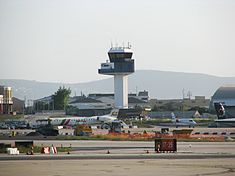Four FREE - International Shipping Quotes to Lisbon, Portugal
With the help of internationalShipping.com international shipping to Lisbon, Portugal can be so much easier! The Best International shipping Companies in the country will compete for your move to Portugal. You will receive up to four free Lisbon, Portugal moving quotes. The information you provide on this web site will only be used for your upcoming move from The United States of America (U.S.A.) to Lisbon, Portugal and will not be transferred or sold to any other vender's .
Lisbon, Portugal

Portugal International Airport.
Portugal Airport
Lisbon , Portugal
Lisbon Portela Airport, also known as Lisbon Airport (IATA: LIS, ICAO: LPPT), is located 7 km (4.3 mi) north of Castle of São Jorge in the city of Lisbon, the capital of Portugal. In Portuguese, it is called Aeroporto de Lisboa, Aeroporto da Portela, or Aeroporto da Portela de Sacavém. It takes its name from the neighbouring parish (freguesia) of Portela, also known as Portela de Sacavém. There are current negotiations with Ryanair to install a hub at Lisbon airport in the Summer of 2011.
The airport is the main international gateway to Portugal and a major European hub. It is one of the largest airports in Southern Europe. The airport has two main runways, capable of accommodating large-size aircraft such as the Boeing 747. During World War II, as the neutral airport was open to both German and British airlines, it was a hub for smuggling people into, out of and all around Europe, as widely referenced in the classic Casablanca movie, whose plot revolved around an escape attempt to Lisbon airport. As such, it was heavily monitored by both Axis and Allied spies. In 2009, the airport handled 13,277,959 passengers and 83,367 tonnes of cargo. The airport is the main base-hub of TAP Portugal. The airport is run by State-owned company ANA Aeroportos de Portugal. It`s a hub for TAP Portugal, Easyjet [begins Winter 2011], SATA International, Portugália and White Airways.
The airport was opened on 15 October 1942, with four 1,000 m (3,300 ft) runways. It quickly expanded, with extended runways and a new terminal. It also expanded its parking facilities to allow more aircraft movements (110,437 in 2002). It has sixteen jetways.
History
The airport was opened during the Second World War, although Portugal was neutral the airport was used by allied flights enroute to Gibraltar, North Africa and Cairo. At the end of the war the airport developed quickly and by 1946 was used by major airlines like Air France, British European Airways, Iberia, KLM, Sabena, Pan Am and Trans World Airlines and by 1954 the number of passengers had reached 100,000. A major upgrade was started in 1959 and completed in 1962 this included a new runway capable of taking the first generation jets, Boeing 707 and Douglas DC-8. The first jet aircraft movement was an Air France Caravelle in 1960. In 1962 Runway 03/21 came into use, it was 3130m (10,270 ft) and would allow direct transatlantic flights. The first direct flight to New York was operated by a TWA Boeing 707 who also operated the first Boeing 747 service in 1970. When TAP ordered the 747, five large parking bays were built in 1972 and the terminal was enlarged. A major upgrade to the buildings and facilities was started in 1983 and the first air bridges were added in 1991.
Replacement
The airport is now completely surrounded by urban development, being one of the few airports in Europe located inside a major city. This led to a national debate on whether to keep the present location or to build a new airport, the last option was chosen. Initially, Ota, a village 50 km (31 mi) north of Lisbon, was chosen as one of the sites for the new airport. In 2007 an independent study coordinated by the Portuguese Industry Confederation (CIP) suggested Alcochete as an alternative location (see Alcochete Airport). In Alcochete a military training facility currently occupies the site, but the military agreed to abandon the location provided they could transfer their facility to a different area. A second government-contracted study led by the National Laboratory of Civil Engineering (LNEC) concluded in late 2007 that Alcochete was the best location.
The selection of Alcochete was announced on 10 January 2008, more than 35 years after the first capacity increase studies were initiated. Portuguese prime minister José Sócrates announced that Alcochete was the preliminary choice, to be finalized after public consultation. The location of Alcochete as the construction site of the future Lisbon Airport was confirmed by the Portuguese Government on 8 May 2008.


